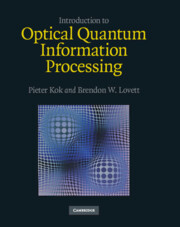Book contents
- Frontmatter
- Dedication
- Contents
- Preface
- Part I Quantum optics and quantum information
- Part II Quantum information in photons and atoms
- Part III Quantum information in many-body systems
- 8 Quantum communication with continuous variables
- 9 Quantum computation with continuous variables
- 10 Atomic ensembles in quantum information processing
- 11 Solid-state quantum information carriers
- 12 Decoherence of solid-state qubits
- 13 Quantum metrology
- Appendix A Baker–Campbell–Haussdorff relations
- Appendix B The Knill–Laflamme–Milburn protocol
- Appendix C Cross–Kerr nonlinearities for single photons
- References
- Index
11 - Solid-state quantum information carriers
from Part III - Quantum information in many-body systems
Published online by Cambridge University Press: 05 July 2014
- Frontmatter
- Dedication
- Contents
- Preface
- Part I Quantum optics and quantum information
- Part II Quantum information in photons and atoms
- Part III Quantum information in many-body systems
- 8 Quantum communication with continuous variables
- 9 Quantum computation with continuous variables
- 10 Atomic ensembles in quantum information processing
- 11 Solid-state quantum information carriers
- 12 Decoherence of solid-state qubits
- 13 Quantum metrology
- Appendix A Baker–Campbell–Haussdorff relations
- Appendix B The Knill–Laflamme–Milburn protocol
- Appendix C Cross–Kerr nonlinearities for single photons
- References
- Index
Summary
In this chapter we will discuss solid-state quantum computing, concentrating on systems where qubit manipulation, initialization or readout is performed optically. We will begin with a discussion of crystals with a periodic lattice and derive Bloch's theorem, which sets constraints on the form of electronic wave functions in crystals. We will then introduce semiconductor heterostructures and show that these have a discrete energy-level structure with transitions corresponding to the optical region of the electromagnetic spectrum. The discrete levels can be used as several different kinds of qubit, and we will discuss two that can be manipulated optically, namely an electron spin and an exciton. We will touch upon crystal defects and their importance in optical quantum computing. The emphasis will be on the NV− centre in diamond, which has produced some of the most important experimental results in recent years. Towards the end of the chapter, we will discuss specific implementations of single- and two-qubit gates in solid-state structures, before concluding with some methods for scaling up a solid-state device to a full-scale quantum computer.
Basic concepts of solid-state systems
In order to understand the optical characteristics of semiconductors, we must first review some basic concepts from solid-state physics. In particular, we will need the form and properties of the electronic wave functions in a periodic crystal structure. Unfortunately, the calculation of electronic states in a solid is impossible to do exactly.
- Type
- Chapter
- Information
- Introduction to Optical Quantum Information Processing , pp. 361 - 396Publisher: Cambridge University PressPrint publication year: 2010



